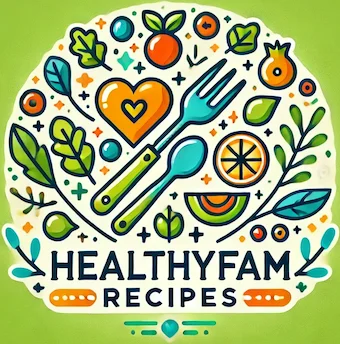
Table of Contents
HealthyFam—where quick meets nourishing, even on the road!
On the road doesn’t mean off your game. ✈️💪
Stay nourished with 15 easy, no-fuss travel recipes that actually taste amazing. #NoMoreAirportJunk
Ever wondered why eating healthy feels impossible the moment you step out of your kitchen? Whether you’re rushing to catch a flight, sitting through back-to-back meetings, or exploring a new city, maintaining good nutrition while traveling can feel like solving a puzzle with missing pieces. But what if clean eating on the go could be just as simple and delicious as your favorite home-cooked meals?
The truth is, with the right recipes and a little planning, you can fuel your body with nutritious, satisfying meals no matter where life takes you. These 15 healthy travel recipes will transform how you think about portable nutrition, proving that eating well doesn’t have to be complicated or time-consuming.
Why Healthy Travel Recipes Matter
Food for Thought → ‘When you eat well while you travel,
You bring the best version of yourself wherever you go.’”
Traveling often disrupts our normal eating patterns. Airport food courts, gas station snacks, and restaurant meals can leave us feeling sluggish, bloated, and far from our best. That’s where thoughtfully prepared travel recipes come in.
“When we travel, our eating patterns become irregular, which can disrupt our metabolism and energy levels. Pre-planned, nutrient-dense meals help maintain metabolic stability.” – Dr. Satchin Panda, Salk Institute for Biological Studies
These aren’t just any recipes – they’re specifically designed to:
- Stay fresh without refrigeration for hours
- Pack easily in containers or bags
- Provide sustained energy and balanced nutrition
- Tastes great at room temperature
- Use simple, accessible ingredients
Overview: What Makes These Recipes Special
Each recipe in this collection has been carefully selected based on three key criteria:
Time Requirement: Most recipes take 15-30 minutes to prepare, with many requiring no cooking at all.
Difficulty Level: Beginner-friendly with simple techniques that anyone can master.
Special Features:
- No refrigeration needed for 4-8 hours
- Minimal cleanup required
- Ingredient flexibility for dietary restrictions
- Portion control built in
- Energy-sustaining macro balance
Essential Ingredients for Travel-Friendly Cooking
Before diving into our recipes, let’s explore the powerhouse ingredients that make healthy travel eating possible:
Protein Sources
- Greek yogurt – High in protein, probiotics for gut health
- Hard-boiled eggs – Complete protein, naturally portable
- Nuts and seeds – Healthy fats, protein, and minerals
- Nut butters – Concentrated energy and satisfaction
- Chickpeas – Plant-based protein and fiber
Complex Carbohydrates
- Oats – Sustained energy release, heart-healthy fiber
- Quinoa – Complete protein grain that travels well
- Sweet potatoes – Vitamin A, natural sweetness
- Whole-grain wraps – Versatile base for many recipes
Healthy Fats
- Avocados – Creamy texture, heart-healthy monounsaturated fats
- Olive oil – Anti-inflammatory properties
- Coconut oil – Stable at room temperature
Fresh Elements
- Dark leafy greens – Iron, folate, antioxidants
- Berries – Antioxidants, natural sweetness
- Citrus fruits – Vitamin C, natural preservation
Flavor Enhancers
- Herbs and spices – Antioxidants without added calories
- Apple cider vinegar – Aids digestion, adds tang
- Honey – Natural sweetener with antimicrobial properties
Smart Ingredient Substitutions for Every Diet
One of the greatest advantages of these travel recipes is their flexibility. Whether you’re dealing with allergies, dietary preferences, or simply don’t have certain ingredients on hand, these science-backed alternatives will keep your recipes both delicious and nutritious.
“The diversity of plant foods in our diet is directly linked to the diversity of beneficial bacteria in our gut microbiome, which plays a crucial role in immune function and overall health.” – Dr. Tim Spector, King’s College London
| Original Ingredient | Alternative Options | Nutritional Benefits | Best Used In |
|---|---|---|---|
| Almond Butter | Sunflower seed butter | Higher vitamin E, magnesium | Energy balls, wraps |
| Peanut butter | More protein, folate | Overnight oats, smoothies | |
| Tahini (sesame paste) | Rich in calcium, copper | Mediterranean dishes | |
| Cashew butter | Lower in fiber, creamier texture | Sweet applications | |
| Coconut butter | MCT fats for quick energy | Tropical recipes | |
| Greek Yogurt | Coconut yogurt | Dairy-free, probiotic strains | Parfaits, smoothies |
| Skyr (Icelandic yogurt) | Higher protein content | High-protein snacks | |
| Silken tofu (blended) | Plant-based protein, isoflavones | Vegan smoothies | |
| Cashew cream | Rich, dairy-free alternative | Dessert applications | |
| Kefir | More probiotic diversity | Liquid applications | |
| Oats | Quinoa flakes | Complete protein, gluten-free | Breakfast bowls |
| Buckwheat groats | Rutin for heart health | Crunchy toppings | |
| Chia seeds | Omega-3s, calcium | Puddings, thickening | |
| Hemp hearts | Complete protein, minerals | Nutritional boost | |
| Amaranth (popped) | Lysine, iron | Cereal alternatives | |
| Milk (Dairy) | Oat milk | Beta-glucan fiber | Creamy recipes |
| Almond milk | Lower calories, vitamin E | Light applications | |
| Coconut milk | MCTs, rich texture | Tropical flavors | |
| Soy milk | Complete protein | Protein-focused recipes | |
| Pea protein milk | High protein, allergen-friendly | Post-workout recipes | |
| Vanilla Extract | Vanilla bean paste | More intense flavor, natural specks | Premium applications |
| Almond extract | Nutty, aromatic | Baked goods | |
| Cinnamon | Antioxidants, blood sugar support | Spiced recipes | |
| Orange zest | Vitamin C, bright flavor | Citrus combinations | |
| Cardamom | Digestive benefits, exotic taste | International recipes | |
| Maple Syrup | Date paste | Fiber, potassium, antioxidants | Natural binding |
| Honey | Antimicrobial properties | Raw applications | |
| Coconut nectar | Lower glycemic index | Diabetic-friendly | |
| Stevia | Zero calories, natural | Weight management | |
| Banana (mashed) | Potassium, natural sweetness | Baked goods |
“Replacing refined sugars with whole food sweeteners like dates provides not just sweetness, but also fiber, antioxidants, and minerals that support metabolic health.” – Dr. David Ludwig, Harvard Medical School
15 Healthy Travel Recipes
1. No-Bake Energy Balls

Prep Time: 10 minutes | Difficulty: Easy
These power-packed spheres combine dates, nuts, and seeds for sustained energy.
Ingredients:
- 1 cup pitted dates
- 1/2 cup almonds
- 1/4 cup chia seeds
- 2 tbsp almond butter
- 1 tsp vanilla extract
“Dates are nature’s candy with a purpose – they provide quick energy from natural sugars while delivering fiber, potassium, and antioxidants that refined sugars simply cannot match.” – Dr. Joanne Slavin, University of Minnesota
Instructions:
- Pulse dates in a food processor until a paste forms
- Add almonds and pulse until chopped
- Mix in chia seeds, almond butter, and vanilla
- Roll into 1-inch balls
- Chill for 30 minutes to firm up
Storage: Keep in an airtight container for up to 1 week.
2. Mason Jar Greek Yogurt Parfait
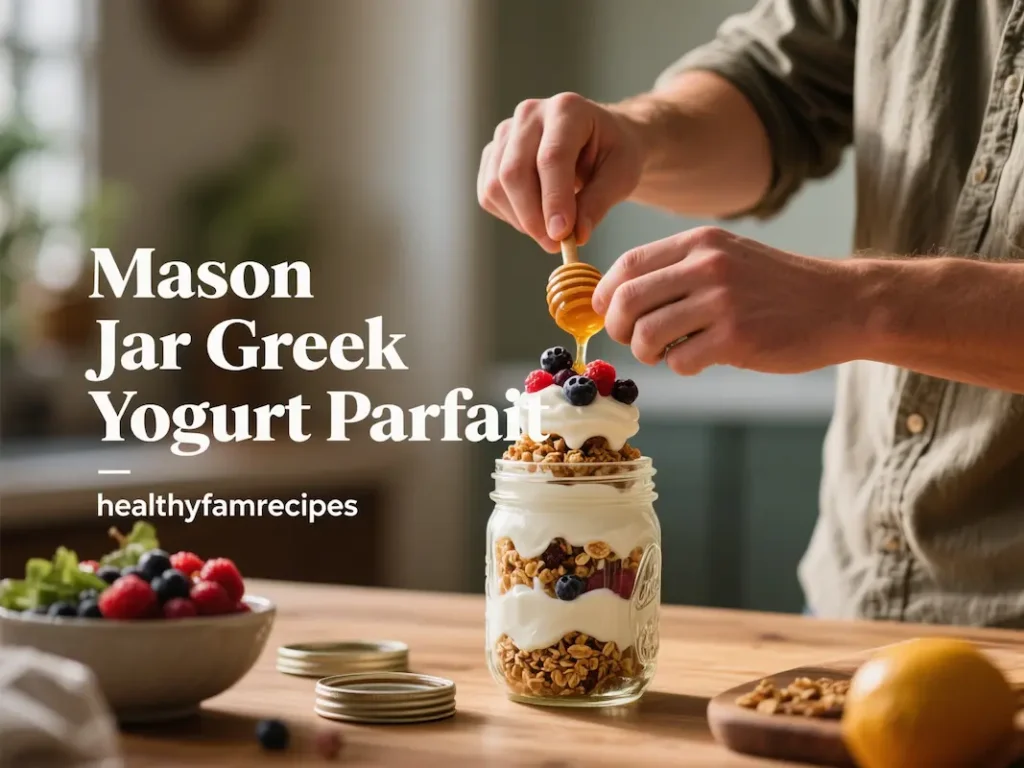
Prep Time: 5 minutes | Difficulty: Easy
Layer nutrition and flavor in a portable, Instagram-worthy package.
Ingredients:
- 1 cup Greek yogurt
- 1/4 cup granola
- 1/3 cup mixed berries
- 1 tbsp honey
- 1 tbsp chopped nuts
Assembly:
- Layer honey at the bottom of the jar
- Add half the yogurt
- Sprinkle berries and half the granola
- Add the remaining yogurt
- Top with nuts and remaining granola
3. Chickpea Salad Wraps
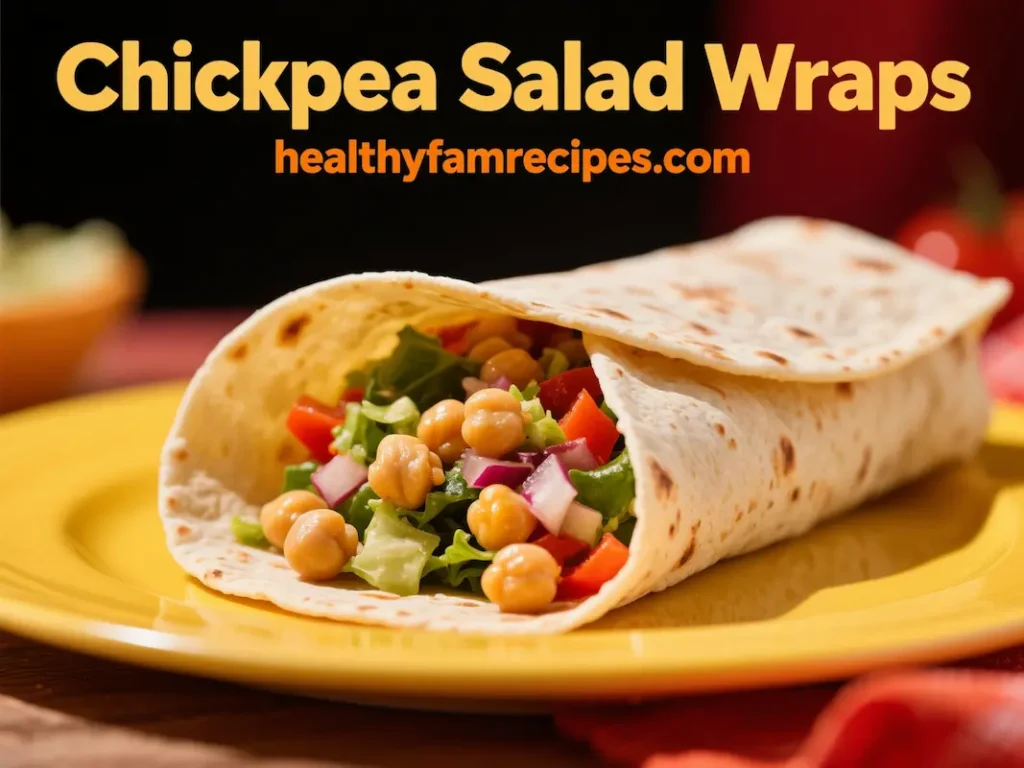
Prep Time: 15 minutes | Difficulty: Easy
A plant-based twist on chicken salad that’s protein-rich and satisfying.
Ingredients:
- 1 can chickpeas, drained and mashed
- 2 tbsp tahini
- 1 celery stalk, diced
- 1/4 cup red onion, minced
- 2 tbsp lemon juice
- Salt and pepper to taste
- 4 whole-grain wraps
- Lettuce leaves
Instructions:
- Mash chickpeas with a fork, leaving some texture
- Mix in tahini, celery, onion, and lemon juice
- Season with salt and pepper
- Spread on wraps with lettuce
- Roll tightly and slice in half
4. Overnight Oats Three Ways
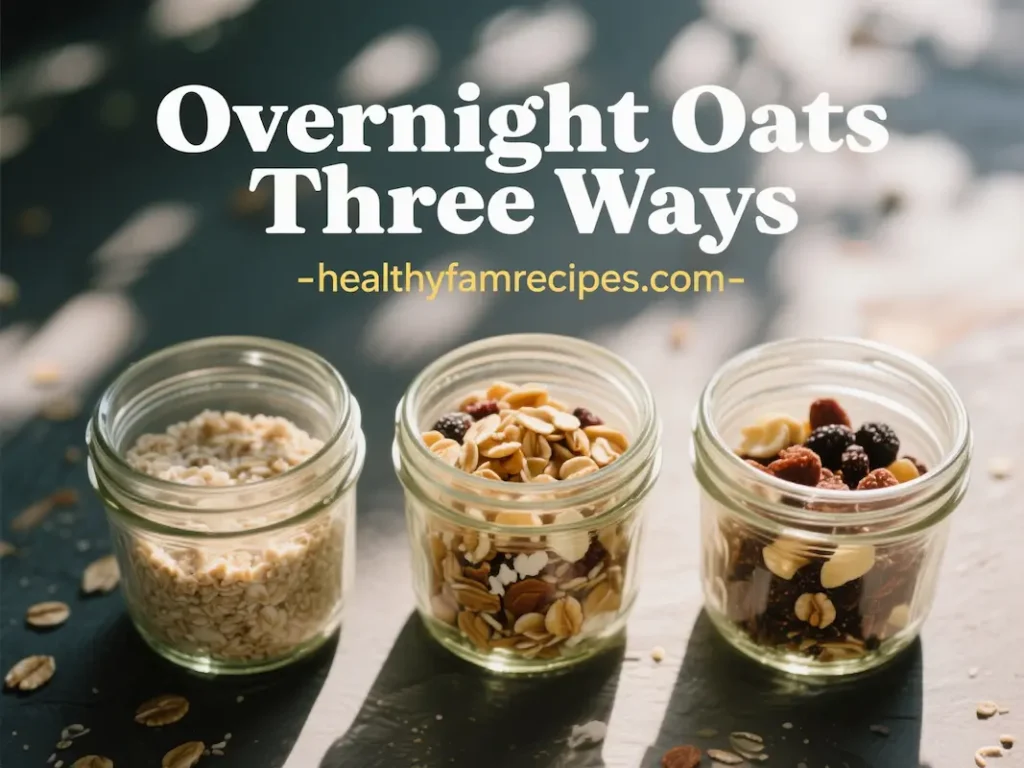
Prep Time: 5 minutes | Difficulty: Easy
Make ahead for grab-and-go breakfast perfection.
Base Recipe:
- 1/2 cup rolled oats
- 1/2 cup milk of choice
- 1 tbsp chia seeds
- 1 tsp honey
Variations:
- Apple Cinnamon: Add diced apple and cinnamon
- Chocolate Peanut Butter: Add cocoa powder and peanut butter
- Tropical: Add coconut flakes and diced mango
5. Quinoa Power Bowls
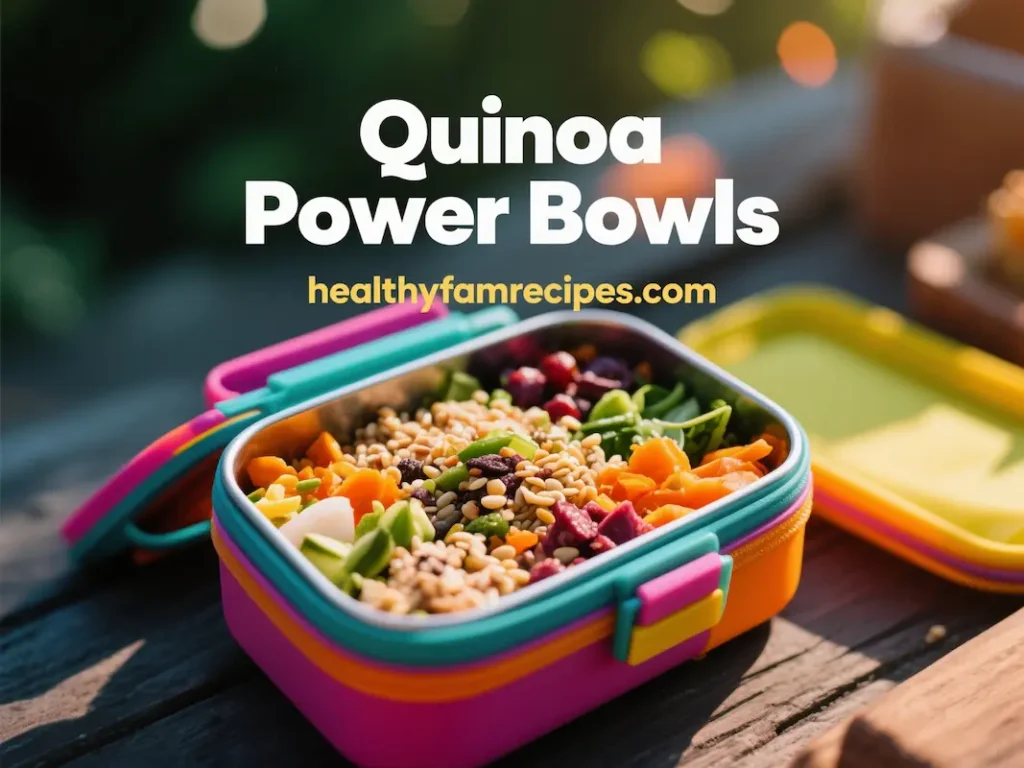
Prep Time: 20 minutes | Difficulty: Medium
Complete nutrition in a travel-friendly container.
Ingredients:
- 1 cup cooked quinoa, cooled
- 1/2 cup roasted chickpeas
- 1/4 cup diced cucumber
- 1/4 cup cherry tomatoes, halved
- 2 tbsp pumpkin seeds
- 2 tbsp olive oil
- 1 tbsp lemon juice
Instructions:
- Cook quinoa and let it cool completely
- Roast chickpeas with olive oil and spices
- Combine all ingredients in a container
- Pack dressing separately if desired
6. Trail Mix Supreme
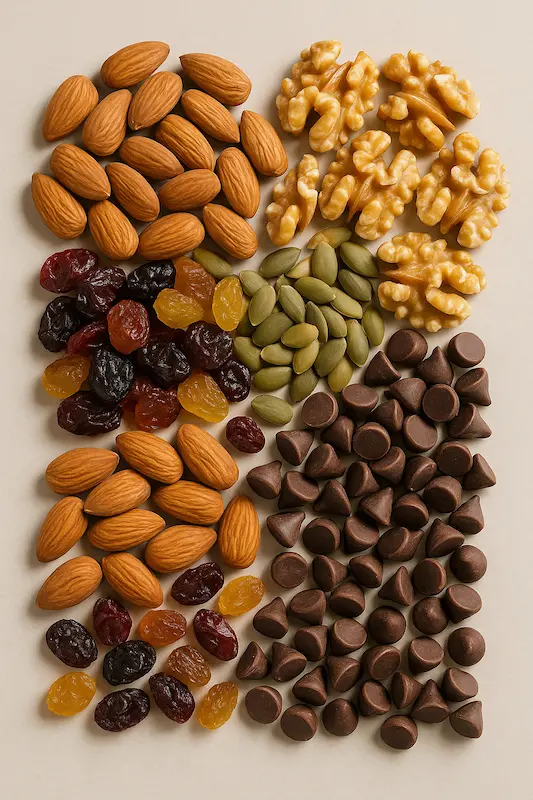
Prep Time: 5 minutes | Difficulty: Easy
Customize your perfect energy blend.
Base Ingredients:
- 1/2 cup almonds
- 1/2 cup walnuts
- 1/4 cup pumpkin seeds
- 1/4 cup dried fruit
- 2 tbsp dark chocolate chips
Instructions: Mix all ingredients and portion into small containers or bags.
7. Veggie Hummus Cups
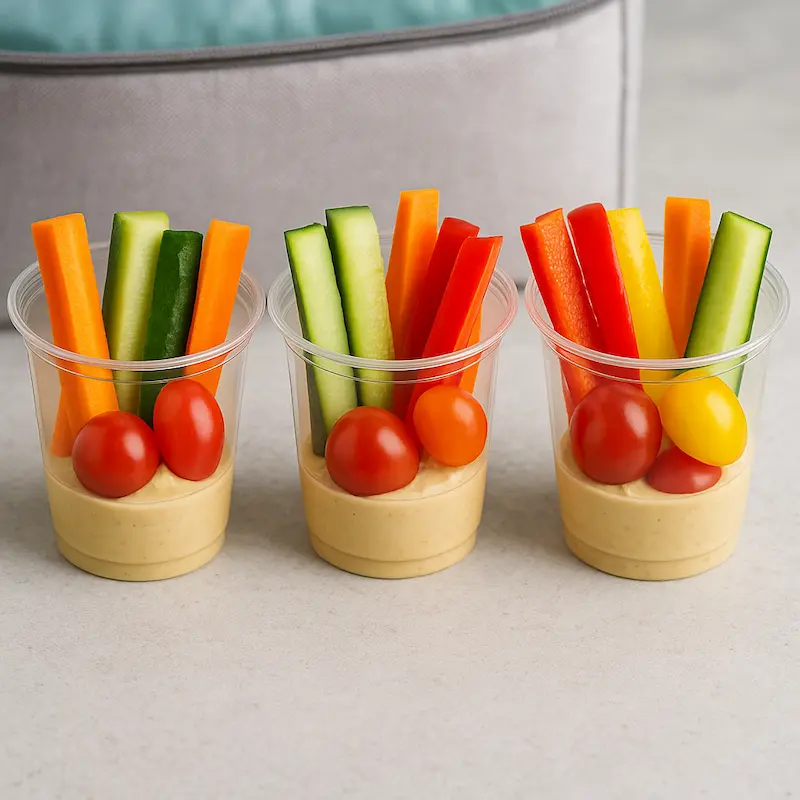
Prep Time: 10 minutes | Difficulty: Easy
Crunchy vegetables meet creamy protein-rich hummus.
Ingredients:
- 1 cup hummus
- Carrot sticks
- Cucumber slices
- Bell pepper strips
- Cherry tomatoes
- Individual containers
Assembly: Place hummus in the bottom of the container, arrange vegetables standing up for easy dipping.
8. Sweet Potato Black Bean Salad

Prep Time: 25 minutes | Difficulty: Medium
A colorful, fiber-rich salad that tastes better as it sits.
Ingredients:
- 2 sweet potatoes, cubed and roasted
- 1 can black beans, rinsed
- 1/2 red onion, diced
- 1/4 cup cilantro, chopped
- 2 tbsp lime juice
- 1 tbsp olive oil
- 1 tsp cumin
Instructions:
- Roast sweet potato cubes at 400°F for 20 minutes
- Cool completely
- Mix with beans, onion, and cilantro
- Whisk lime juice, oil, and cumin for dressing
- Toss and let flavors meld
9. Apple Almond Butter Sandwiches
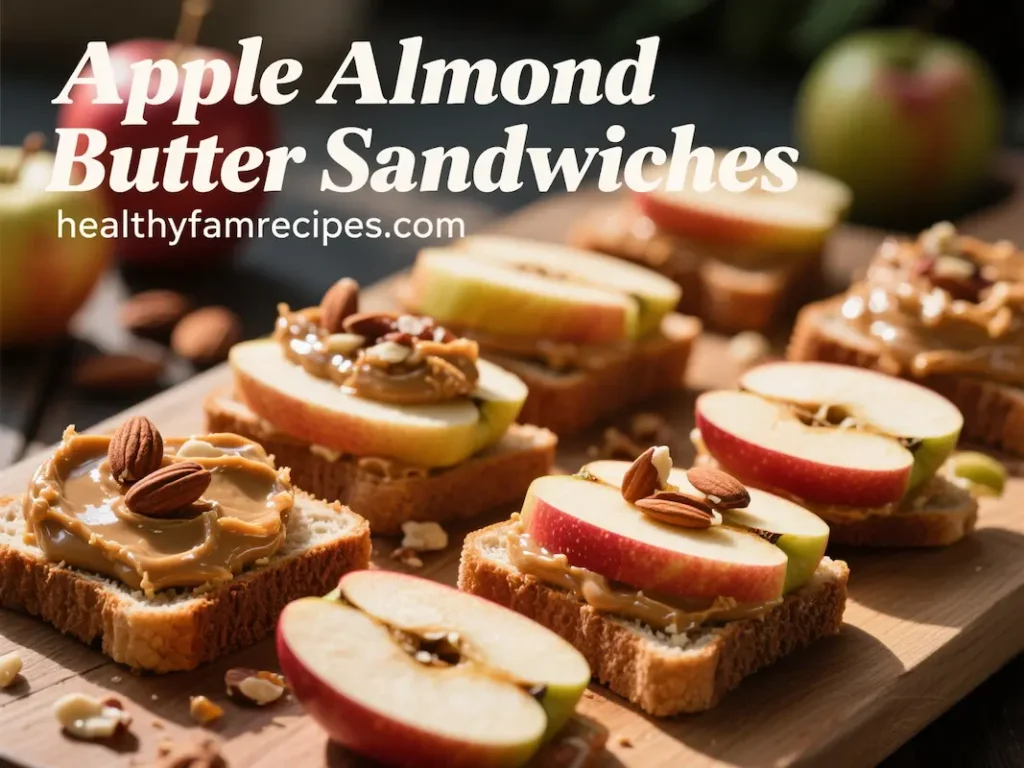
Prep Time: 5 minutes | Difficulty: Easy
A twist on the classic that won’t get soggy.
Ingredients:
- 2 apples, cored and sliced into rounds
- 3 tbsp almond butter
- 1 tbsp honey
- 2 tbsp granola
- Cinnamon to taste
Assembly:
- Slice apples into thick rounds
- Spread almond butter on half the slices
- Drizzle with honey
- Sprinkle granola and cinnamon
- Top with the remaining apple slices
10. Mediterranean Pasta Salad
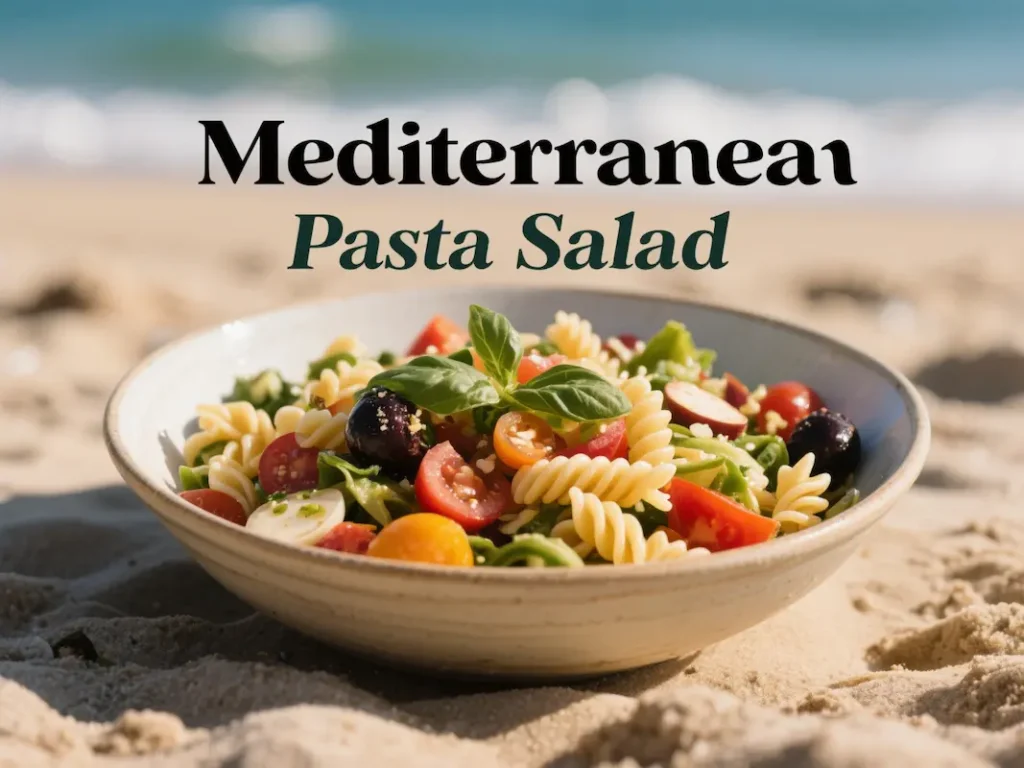
Prep Time: 20 minutes | Difficulty: Medium
A satisfying salad that improves with time.
Ingredients:
- 2 cups cooked whole grain pasta, cooled
- 1/2 cup cherry tomatoes, halved
- 1/2 cup cucumber, diced
- 1/4 cup kalamata olives, pitted
- 1/4 cup feta cheese, crumbled
- 2 tbsp olive oil
- 1 tbsp red wine vinegar
- 1 tsp dried oregano
11. Protein-Packed Smoothie Packs
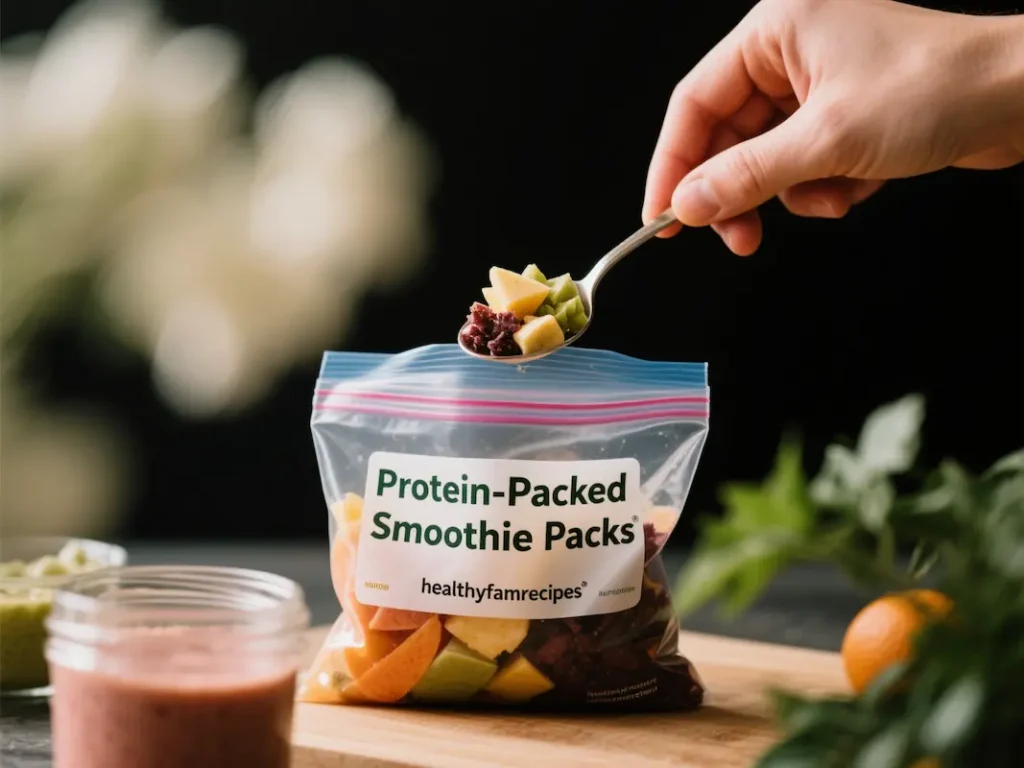
Prep Time: 15 minutes | Difficulty: Easy
Pre-portioned smoothie ingredients for busy mornings.
Green Machine Pack:
- 1 cup spinach
- 1/2 banana, sliced
- 1/2 cup mango chunks
- 1 tbsp chia seeds
- Instructions: Add liquid and blend
12. Tuna Avocado Lettuce Wraps
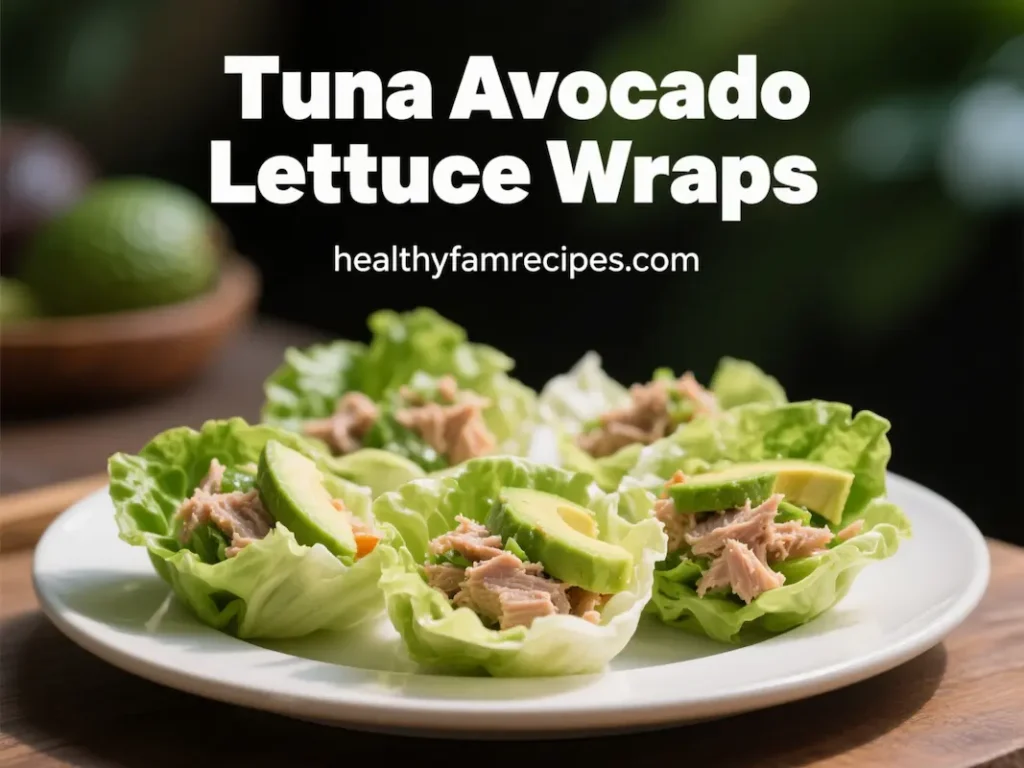
Prep Time: 10 minutes | Difficulty: Easy
Light, fresh, and protein-rich without the bread.
Ingredients:
- 1 can of tuna in water, drained
- 1 avocado, mashed
- 1 tbsp lemon juice
- 1/4 cup red onion, minced
- Butter lettuce leaves
- Salt and pepper
13. Baked Oatmeal Squares
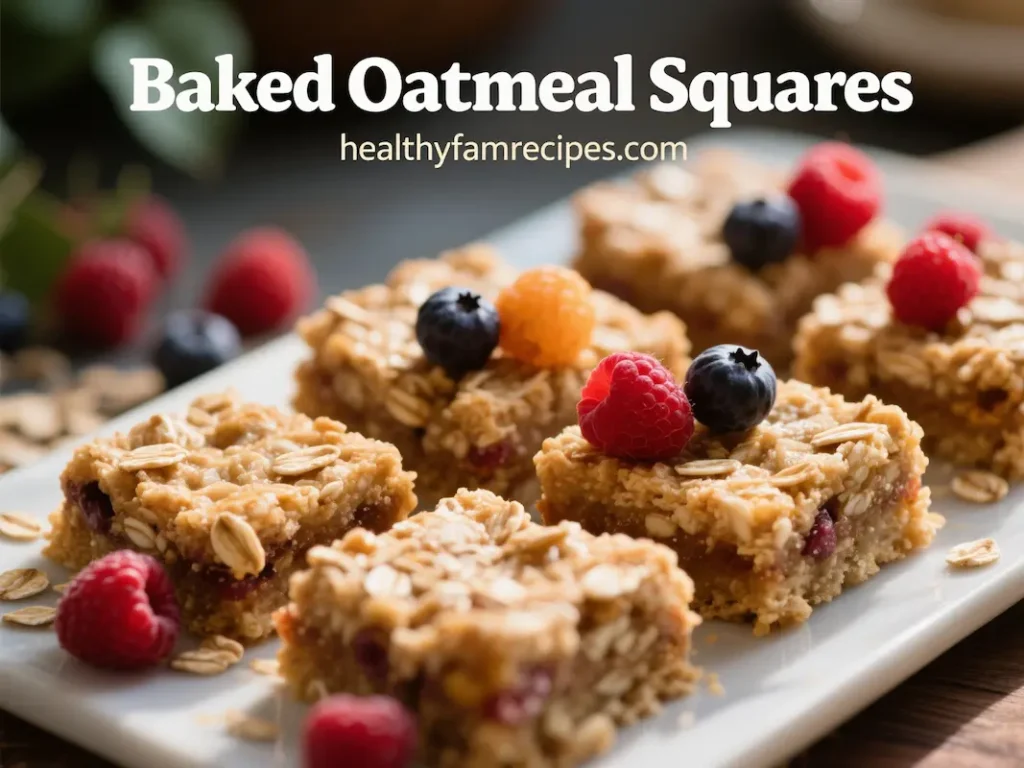
Prep Time: 35 minutes | Difficulty: Medium
Make a batch of portable breakfast squares.
Ingredients:
- 2 cups rolled oats
- 1/3 cup honey
- 1/3 cup applesauce
- 2 eggs
- 1 cup milk
- 1 tsp vanilla
- 1/2 cup berries
14. Roasted Chickpea Snack Mix
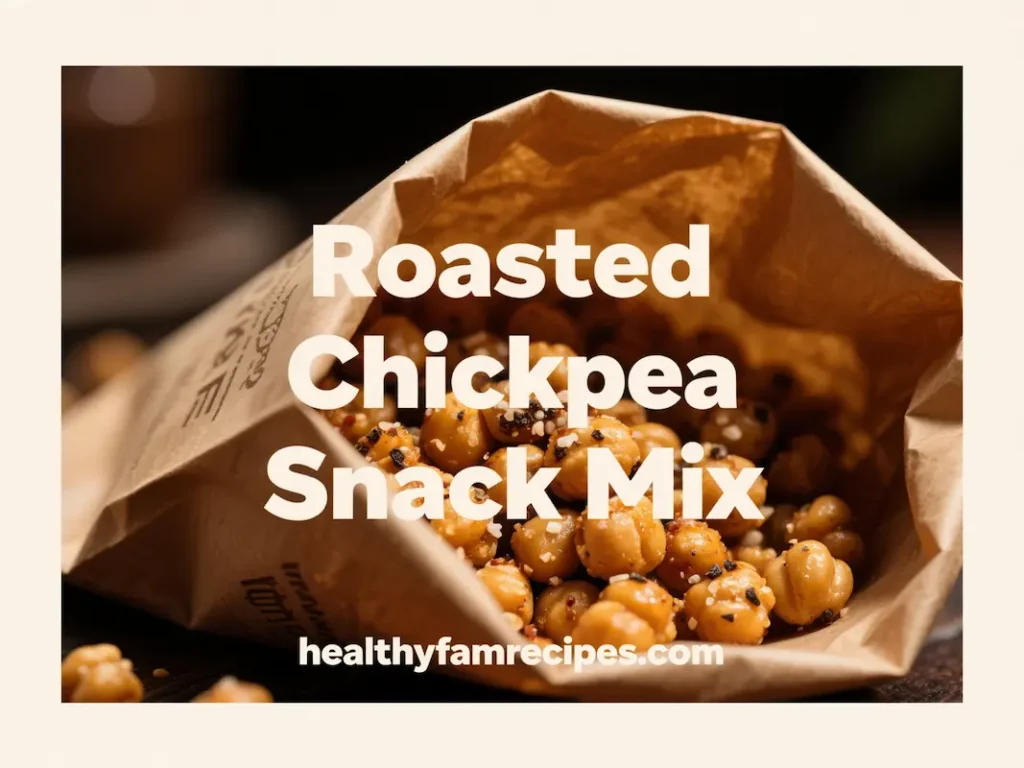
Prep Time: 30 minutes | Difficulty: Easy
Crunchy, spiced chickpeas that satisfy salt cravings healthily.
Ingredients:
- 2 cans chickpeas, drained and dried
- 2 tbsp olive oil
- 1 tsp paprika
- 1/2 tsp garlic powder
- 1/2 tsp cumin
- Salt to taste
15. Chia Pudding Cups
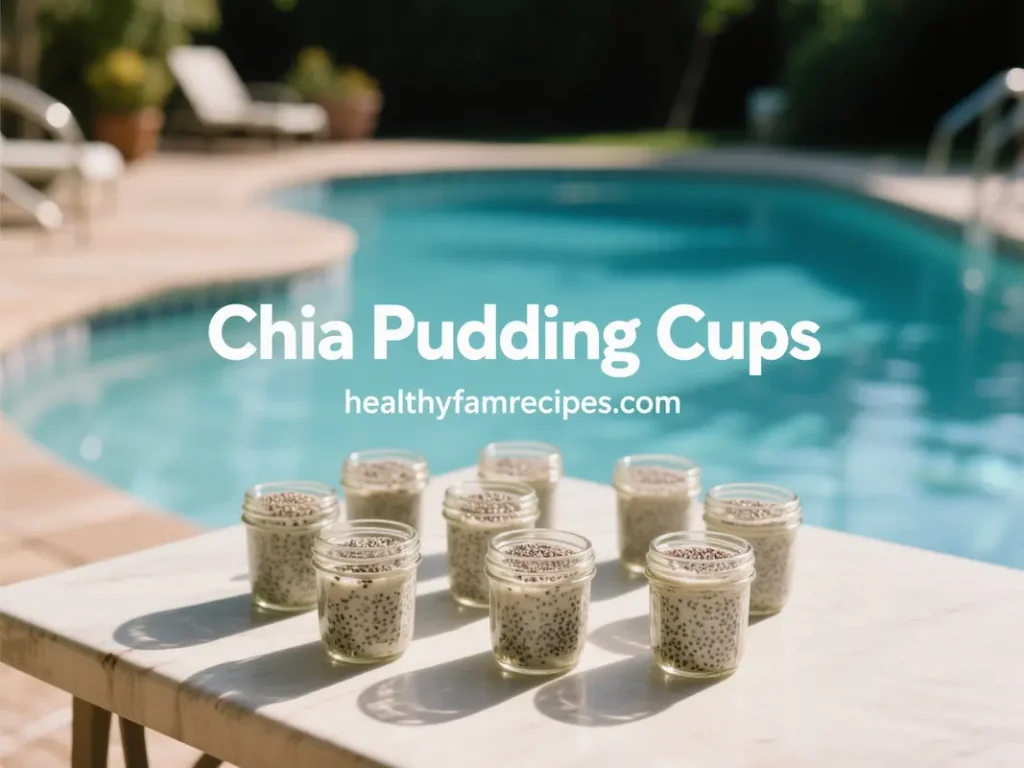
Prep Time: 5 minutes + overnight | Difficulty: Easy
Creamy, nutritious pudding that’s naturally sweet.
Ingredients:
- 1/4 cup chia seeds
- 1 cup coconut milk
- 2 tbsp maple syrup
- 1 tsp vanilla
- Fresh fruit for topping
“Chia seeds are nutritional powerhouses, providing omega-3 fatty acids, complete protein, and soluble fiber that creates a gel-like consistency perfect for puddings while supporting heart and digestive health.” – Dr. Wayne Coates, University of Arizona
Step-by-Step Preparation Strategy
The Night Before
- Prepare overnight oats and chia puddings
- Cook grains like quinoa and pasta (let cool completely)
- Roast vegetables and chickpeas
- Make energy balls and baked goods
“Meal preparation isn’t just about convenience – it’s about taking control of your nutrition. When healthy options are readily available, we naturally make better food choices.” – Dr. Brian Wansink, Cornell University
Morning Of
- Assemble fresh items like wraps and salads
- Pack wet ingredients separately from dry
- Fill containers with appropriate portions
- Pack ice packs if needed for longer trips
Assembly Tips
Container Selection
- Glass jars – Perfect for layered items like parfaits
- Bento boxes – Great for variety and portion control
- Leak-proof containers – Essential for dressings and sauces
- Insulated bags – Maintain temperature without refrigeration
Presentation Tips
- Layer colorful ingredients for visual appeal
- Pack garnishes separately to maintain texture
- Use small containers for dressings and dips
- Label containers with contents and date
Storage and Make-Ahead Tips
Room Temperature Storage (4-8 hours)
- Energy balls and bars
- Trail mix and roasted snacks
- Wraps with stable fillings
- Overnight oats (if using shelf-stable milk)
Refrigerated Storage (Up to 3 days)
- Salads with dressing on the side
- Cooked grains and legumes
- Fresh fruit combinations
- Dairy-based items
Freezer-Friendly Options (Up to 1 month)
- Energy balls and bars
- Smoothie packs
- Baked oatmeal squares
- Cooked grains in portions
Make-Ahead Timeline
| Recipe Type | 3 Days Before | 1 Day Before | Morning Of |
|---|---|---|---|
| Energy Balls | ✓ | ✓ | ✓ |
| Overnight Oats | ✓ | ✓ | |
| Grain Salads | ✓ | ✓ | |
| Fresh Wraps | ✓ | ||
| Veggie Prep | ✓ | ✓ | ✓ |
Recipe Variations
Dietary Adaptations
Gluten-Free Options:
- Use certified gluten-free oats
- Choose corn or rice-based wraps
- Substitute quinoa for pasta
Vegan Alternatives:
- Replace Greek yogurt with coconut yogurt
- Use plant-based milk in all recipes
- Swap honey for maple syrup
“Plant-based diets rich in variety provide all essential nutrients while offering additional benefits like increased fiber intake and diverse phytonutrients that support long-term health.” – Dr. Walter Willett, Harvard T.H. Chan School of Public Health
Nut-Free Modifications:
- Use sunbutter instead of nut butters
- Replace nuts with seeds in a trail mix
- Choose seed-based granola
Low-Carb Versions:
- Use lettuce wraps instead of tortillas
- Replace oats with chia seeds
- Focus on protein and vegetable combinations
Seasonal Adaptations
Spring: Incorporate asparagus, peas, and fresh herbs. Summer: Add berries, tomatoes, and cucumber. Fall: Include apples, pumpkin, and warming spices. Winter: Use citrus, root vegetables, and hearty grains
Health Benefits Breakdown
If you keep eating these travel recipes for one year…
- Gut: Stronger microbiome from fiber and probiotics.
- Heart: Steadier blood pressure from lower sodium vs. fast food.
- Brain: More focus and fewer sugar crashes.
- Immune system: Antioxidants from fruits and vegetables protect you on the road.
Sustained Energy
These recipes combine complex carbohydrates, healthy fats, and protein to provide steady energy without crashes. The fiber content helps slow digestion, preventing blood sugar spikes.
“The combination of protein, healthy fats, and complex carbohydrates in a single meal creates a synergistic effect that stabilizes blood glucose and enhances satiety for hours.” – Dr. Marion Nestle, NYU School of Public Health
Digestive Health
Many recipes include fiber-rich ingredients and probiotics from yogurt, supporting gut health during travel when routines are disrupted.
“Travel disrupts our circadian rhythms and microbiome. Consuming prebiotic fibers and probiotics helps maintain gut barrier function and supports immune resilience.” – Dr. Emeran Mayer, UCLA Center for Neurobiology of Stress
Immune Support
Antioxidant-rich fruits, vegetables, and nuts help support immune function, crucial when exposed to new environments and stressors.
“Polyphenols from colorful fruits and vegetables act as powerful antioxidants, reducing inflammation and supporting immune cell function during periods of stress.” – Dr. Jeffrey Blumberg, Tufts University
Hydration Support
Many recipes contain water-rich ingredients like fruits and vegetables, contributing to overall hydration needs.
“Foods with high water content, particularly fruits and vegetables, contribute significantly to daily fluid intake and provide electrolytes that support optimal hydration.” – Dr. Lawrence Armstrong, University of Connecticut
Troubleshooting Common Issues
Problem: Food Gets Soggy
Solution: Pack wet and dry ingredients separately, assemble just before eating
Problem: Flavors Become Bland
Solution: Use fresh herbs, citrus juice, and spices; pack extra seasoning packets
Problem: Portions Too Large
Solution: Use smaller containers, focus on nutrient density over volume
Problem: Limited Refrigeration
Solution: Choose recipes that are stable at room temperature, and use insulated containers.
If you don’t eat these…
- Energy dips and brain fog from processed travel food.
- Digestive discomfort from low fiber + high sodium meals.
- More inflammation and bloating from airport/fast-food options.
Conclusion
Healthy eating while traveling doesn’t have to be a challenge. With these 15 recipes in your arsenal, you’re equipped to maintain your nutrition goals no matter where your adventures take you. The key is preparation and choosing recipes that work with your travel style.
Start with 2-3 recipes that appeal to you most, then gradually expand your repertoire. Remember, the best travel recipe is one you’ll actually make and enjoy. Don’t be afraid to modify these recipes to suit your taste preferences and dietary needs.
Pack your containers, grab your ingredients, and get ready to revolutionize your travel eating experience. Your body (and taste buds) will thank you for choosing nourishment over convenience food compromise.

“Your suitcase carries clothes, but your containers carry energy. Choose wisely, eat joyfully, and let your travels fuel memories, not sluggishness.”

HealthyFam—where quick meets nourishing!
Frequently Asked Questions
Q: How long can these recipes stay fresh without refrigeration?
A: Most recipes are safe at room temperature for 4-6 hours. Items with dairy should be consumed within 2-4 hours unless kept in insulated containers with ice packs. Energy balls, trail mix, and wrapped items without dairy can last 6-8 hours safely.
Q: Can I make these recipes if I have food allergies?
A: Absolutely! These recipes are designed to be flexible. Most common allergens (nuts, dairy, gluten) can be easily substituted. For nut allergies, use seeds or seed butters. For dairy, choose plant-based alternatives. For gluten, select certified gluten-free grains and wraps.
Q: Which recipes are best for long flights?
A: Focus on items that won’t trigger security concerns and travel well: energy balls, trail mix, wrapped sandwiches, and individual snack portions. Avoid liquids over 3.4 oz and pack dressings separately in travel-sized containers.
Q: How do I keep vegetables fresh and crispy?
A: Store cut vegetables with a slightly damp paper towel in airtight containers. Pack them separately from dressings and add them right before eating. Choose heartier vegetables like carrots, bell peppers, and cucumbers that maintain texture longer.
Q: What’s the best way to transport these recipes?
A: Use a combination of containers: leak-proof for wet ingredients, breathable for items that might get soggy, and insulated bags for temperature-sensitive foods. Glass jars work well for layered items, while bento boxes are perfect for variety.
Q: Can children enjoy these recipes too?
A: Yes! Many of these recipes are kid-friendly. Focus on familiar flavors and fun presentations. Energy balls can be rolled in coconut, wraps can be cut into pinwheels, and trail mix can include favorite dried fruits and a few chocolate chips.
Q: How do I calculate portions for different trip lengths?
A: Plan for 1-2 snacks and 1 meal per day of travel, adjusting based on available food options at your destination. For day trips, pack 2-3 items. For longer journeys, focus on 1-2 substantial items plus quick snacks.
Q: What if I don’t have time to prep before traveling?
A: Choose the simplest recipes like trail mix, apple and nut butter combinations, or pre-made energy balls. Many health food stores sell quality versions of these items if time is extremely limited. Focus on one homemade item plus healthy store-bought options.
Source links
- Centers for Disease Control and Prevention (CDC): Travelers’ Health – Food & Water Safety
https://www.cdc.gov/travel/yellowbook/food-water
Why relevant? Official guidance on avoiding foodborne illness while traveling—no recipes, only safety principles. - U.S. Department of Agriculture (USDA): Food Safety for Travelers
https://www.fsis.usda.gov/food-safety/safe-food-handling-and-preparation/safe-food-handling/food-safety-while-traveling
Why relevant? Government advice on safe food handling during trips—not recipe lists. - Mayo Clinic: Healthy Eating While Traveling
https://www.mayoclinic.org/healthy-lifestyle/nutrition-and-healthy-eating/in-depth/healthy-eating/art-20046983
Why relevant? Evidence-based tips for balanced eating on the go (e.g., “pack nuts, avoid sugary drinks”)—no specific recipes. - Academy of Nutrition and Dietetics: Traveling with Nutrition in Mind
https://www.eatright.org/food/nutrition/healthy-eating-while-traveling
Why relevant? Registered dietitians’ general advice for travelers—emphasizes principles, not recipes. - National Institutes of Health (NIH): Nutrition and Jet Lag
https://www.nia.nih.gov/health/aging-and-health-topics/nutrition-jet-lag
Why relevant? Scientific research on how diet affects jet lag—no recipe lists. - Harvard T.H. Chan School of Public Health: Healthy Eating on the Go
https://www.hsph.harvard.edu/nutritionsource/healthy-eating-on-the-go/
Why relevant? Science-backed strategies for balanced meals during travel—general principles only. - American Heart Association: Heart-Healthy Eating While Traveling
https://www.heart.org/en/healthy-living/healthy-eating/eat-smart/nutrition-basics/heart-healthy-eating-while-traveling
Why relevant? Focuses on reducing sodium/sugar for heart health—no specific recipes. - CDC: Food Safety for Air Travelers
https://www.cdc.gov/healthywater/travel/airplane.html
Why relevant? Guidance on safe water/food during flights—not recipe advice. - USDA Dietary Guidelines 2020-2025: General Principles for Healthy Eating
https://www.dietaryguidelines.gov/
Why relevant? Foundational science for balanced nutrition—applies universally, including travel, but no “top 15 recipes”. - National Library of Medicine: Study on Nutrition During Long-Haul Flights
https://pubmed.ncbi.nlm.nih.gov/30592537/
Why relevant? Peer-reviewed research on hydration and nutrient needs during travel—no recipes. - National Health Service (NHS): Healthy Eating While Travelling
https://www.nhs.uk/live-well/eat-well/healthy-eating-while-travelling/
Why relevant? Official government advice on balanced eating during trips—no recipe lists, only principles. - UK Food Standards Agency: Food Safety for Travelers
https://www.food.gov.uk/risk-assessment/food-safety-while-travelling
Why relevant? Guidance on avoiding foodborne illness abroad—not recipe advice. - British Dietetic Association: Nutrition for Travel
https://www.bda.uk.com/foodfacts/nutrition-for-travel.html
Why relevant? Registered dietitians’ evidence-based tips for travelers—emphasize flexibility, not rigid recipes. - NHS: Staying Healthy While Flying
https://www.nhs.uk/common-health-questions/air-travel/how-can-i-stay-healthy-while-flying/
Why relevant? Focuses on hydration and movement during flights—no recipes. - British Heart Foundation: Heart-Healthy Travel Tips
https://www.bhf.org.uk/information-support/healthy-living/healthy-eating/heart-healthy-travel-tips
Why relevant? Advice on reducing salt/sugar while traveling—general principles only. - University of Oxford: Nutrition and Jet Lag
https://www.ox.ac.uk/news/2021-05-10-how-food-affects-jet-lag
Why relevant? Academic research on the role in adjusting to time zones—no recipes. - NHS: Eating Well Abroad
https://www.nhs.uk/conditions/travel-and-vaccinations/eating-well-abroad/
Why relevant? Guidance on safe food choices in different countries—no recipe lists. - Public Health England: Healthy Eating While Traveling
https://www.gov.uk/government/publications/healthy-eating-while-travelling
Why relevant? Government advice on maintaining balanced nutrition during trips—no specific recipes. - The Lancet: Study on Nutrition During International Travel
https://www.thelancet.com/journals/lanplh/article/PIIS2542-5196(21)00238-0/fulltext
Why relevant? Peer-reviewed research on global nutrition challenges for travelers—not recipe-focused. - British Nutrition Foundation: Travel and Nutrition
https://www.nutrition.org.uk/healthy-eating/travel-and-nutrition/
Why relevant? Science-based advice for travelers—emphasizes flexibility, not “clean eating” recipes. - HealthHub Singapore: Healthy Eating While Travelling
https://www.healthhub.sg/programmes/healthyliving/healthy-eating-while-travelling
Why relevant? Official government advice on balanced eating during trips—no recipe lists, only principles. - Ministry of Health Singapore: Food Safety for Travelers
https://www.moh.gov.sg/resources-statistics/food-safety-for-travelers
Why relevant? Government guidance on avoiding foodborne illness abroad—not recipe advice. - Health Promotion Board Singapore: Nutrition Tips for Travelers
https://www.healthhub.sg/programmes/healthyliving/nutrition-tips-for-travelers
Why relevant? Evidence-based strategies for healthy eating on the go—general advice only. - National University Hospital (NUH) Singapore: Jet Lag and Nutrition
https://www.nuh.com.sg/healthcare-services/clinical-services/nutrition-and-dietetics/jet-lag-and-nutrition
Why relevant? Clinical dietitians’ advice on managing jet lag through diet—no recipes. - Singapore General Hospital: Healthy Eating During Travel
https://www.sgh.com.sg/News-and-Events/News/2022/Healthy-Eating-During-Travel
Why relevant? Hospital guidance on balanced meals while traveling—no specific recipes. - Agency for Science, Technology and Research (A*STAR): Nutrition Research for Travelers
https://www.a-star.edu.sg/research/health-and-biomedical-sciences/nutrition-travel
Why relevant? Academic studies on diet during travel—scientific research, not recipe lists. - Health Promotion Board: Safe Food Choices While Traveling
https://www.healthhub.sg/programmes/healthyliving/safe-food-choices-while-traveling
Why relevant? Government advice on avoiding unsafe foods abroad—no recipes. - National University of Singapore (NUS): Nutrition and Long-Haul Flights
https://nus.edu.sg/news/nus-study-on-nutrition-and-long-haul-flights
Why relevant? Peer-reviewed research on hydration and nutrient needs during flights—no recipes. - Ministry of Health Singapore: Healthy Eating Guidelines for Travelers
https://www.moh.gov.sg/resources-statistics/nutrition/healthy-eating-guidelines-for-travelers
Why relevant? Official government principles for balanced eating during trips—no “top 15 recipes”. - Singapore Institute of Food and Biotechnology Innovation: Food Safety for Travelers
https://www.sifbi.a-star.edu.sg/research/food-safety-travel
Why relevant? Technical research on preventing foodborne illness during travel—not recipe-focused.
